Abstract
Plasma prolactin was measured weekly in 280 preterm infants. The complex gestational age dependent pattern of postnatal prolactin release has been defined and reference standards provided. Plasma prolactin was higher in girls, with increasing divergence between the sexes from the third week onwards, and higher after two weeks, in infants of mothers with pregnancy related hypertension. Diet, assigned randomly, exerted a major effect on plasma prolactin, with significantly higher values in infants fed donor breast milk or standard formula than in those fed a protein, energy, and mineral enriched preterm formula. After adjusting for confounding factors, infants with the lowest plasma prolactin concentrations (less than 1000 mU/l, 32.9 micrograms/l) occurring usually at a nadir between days 5 and 12, showed a 120% increase in the duration of ventilatory assistance required, a 20% increase in the number of days to attain full enteral feeds, and a 30% decrease in length gain. We suggest preterm birth disrupts the normal perinatal pattern of prolactin release and that those infants who develop relatively low plasma concentration have an adverse outcome. Our data add to the broader debate on whether preterm infants require multiple endocrine replacement treatment.
Full text
PDF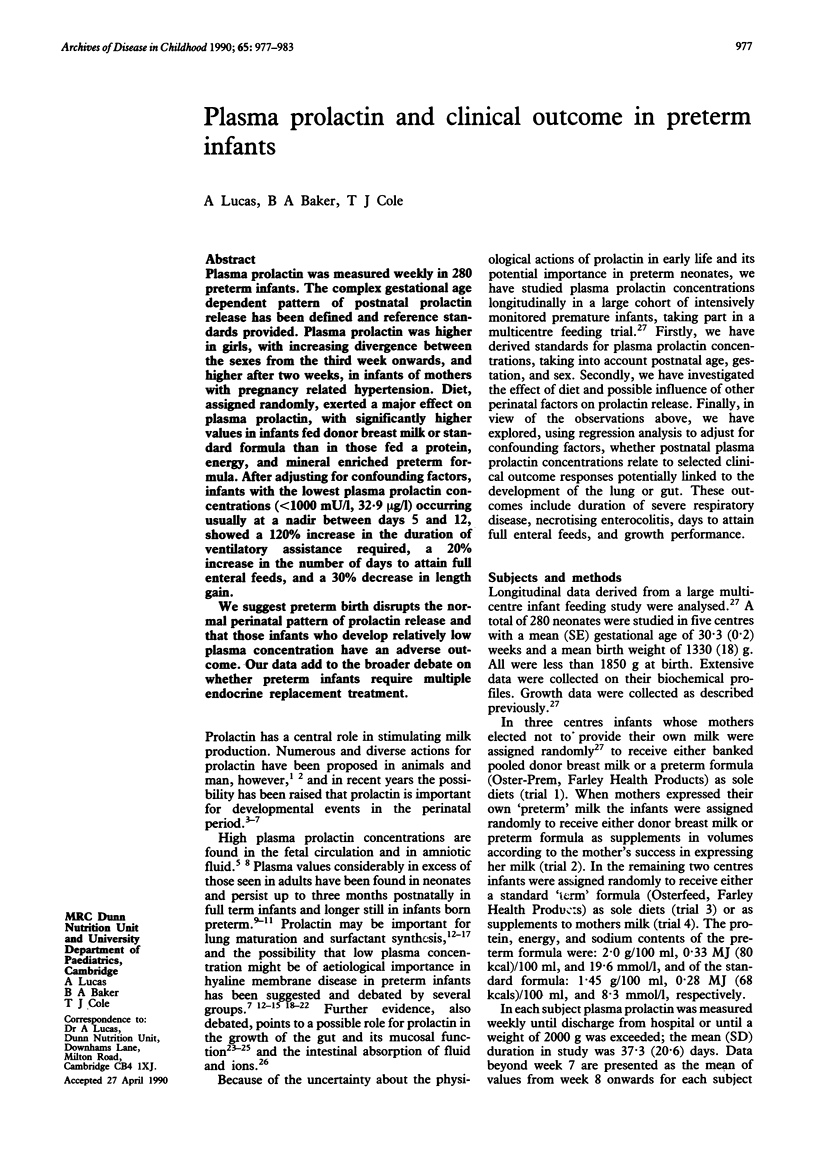
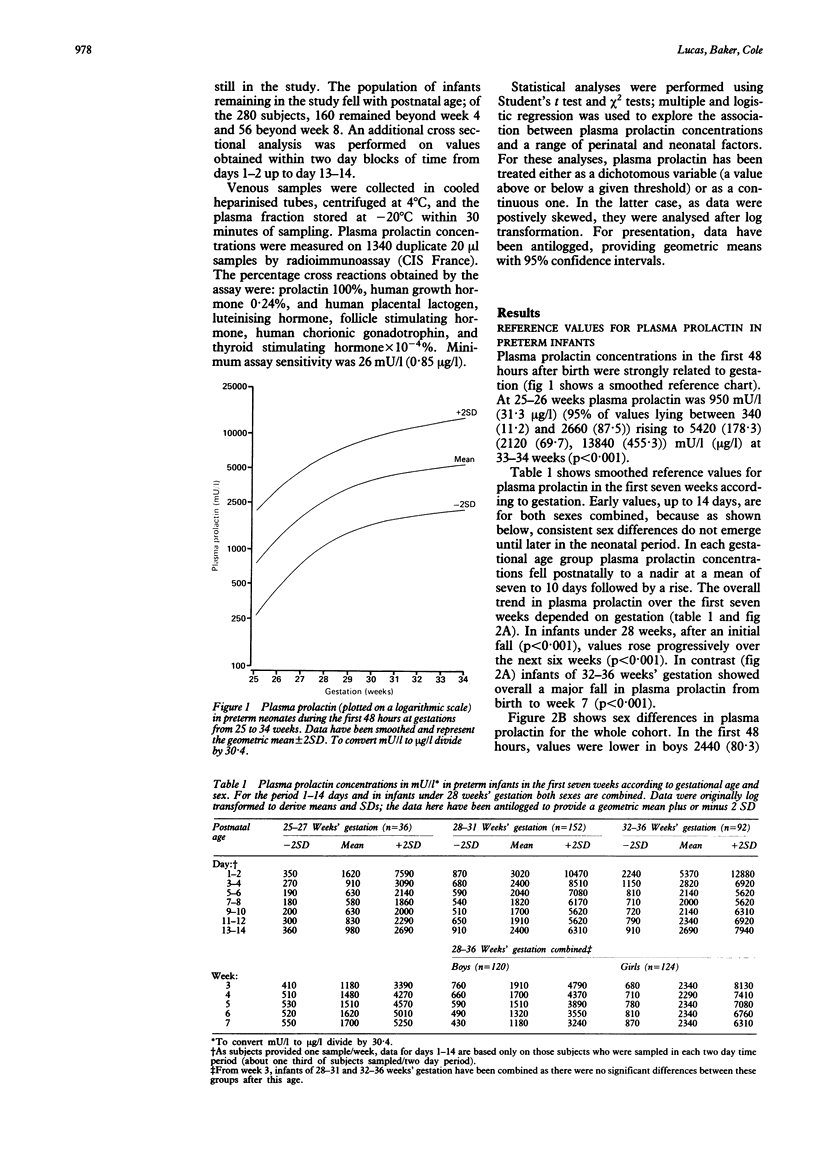
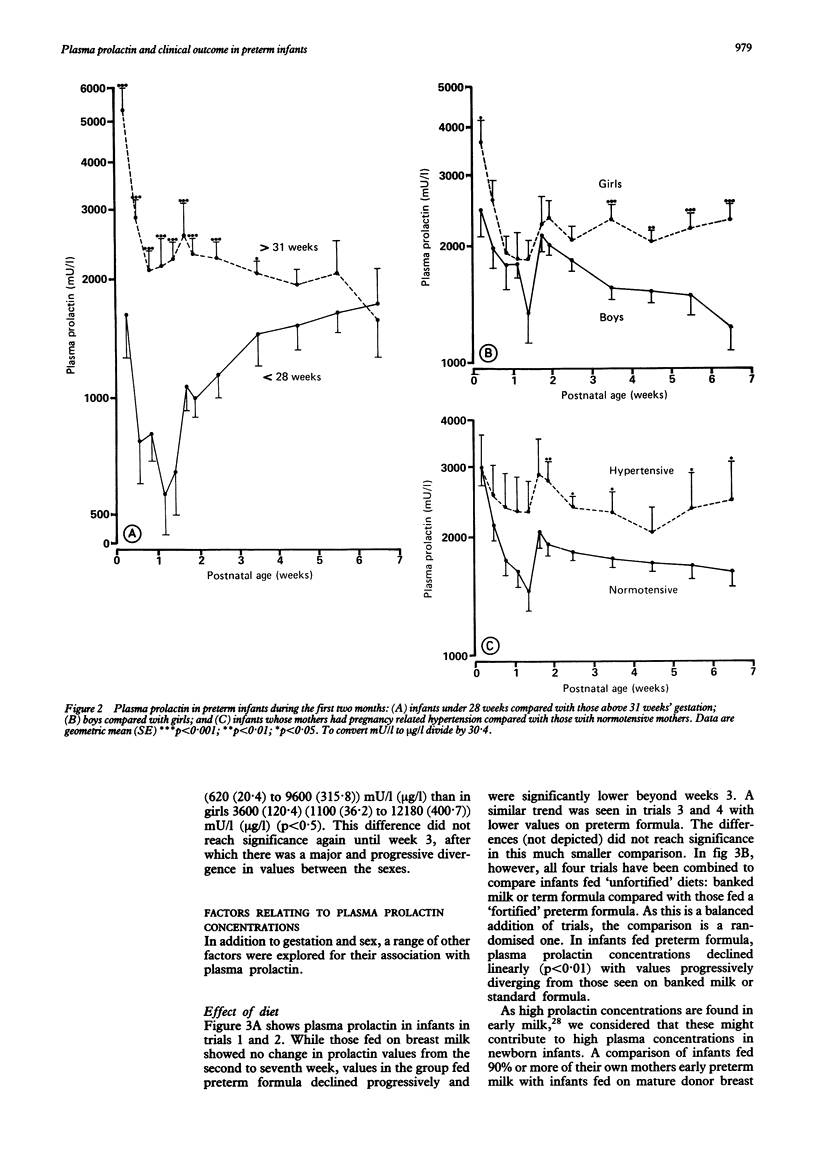
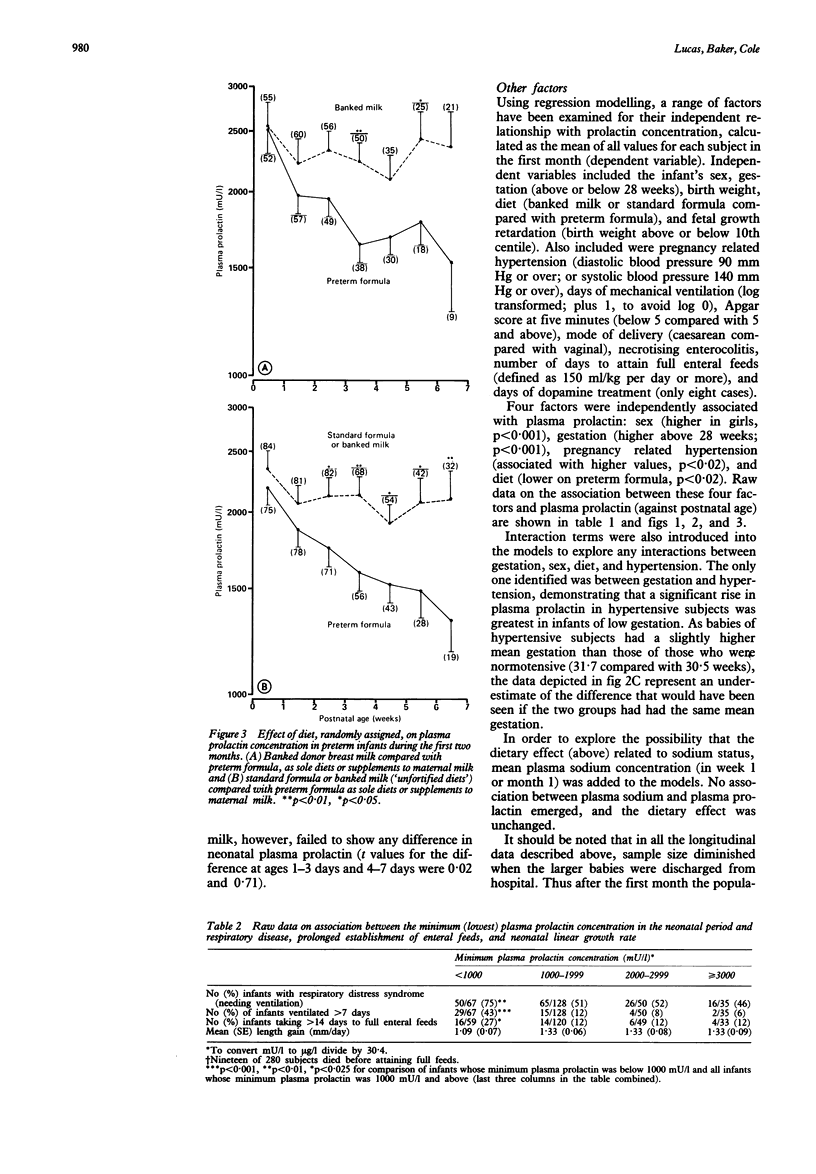
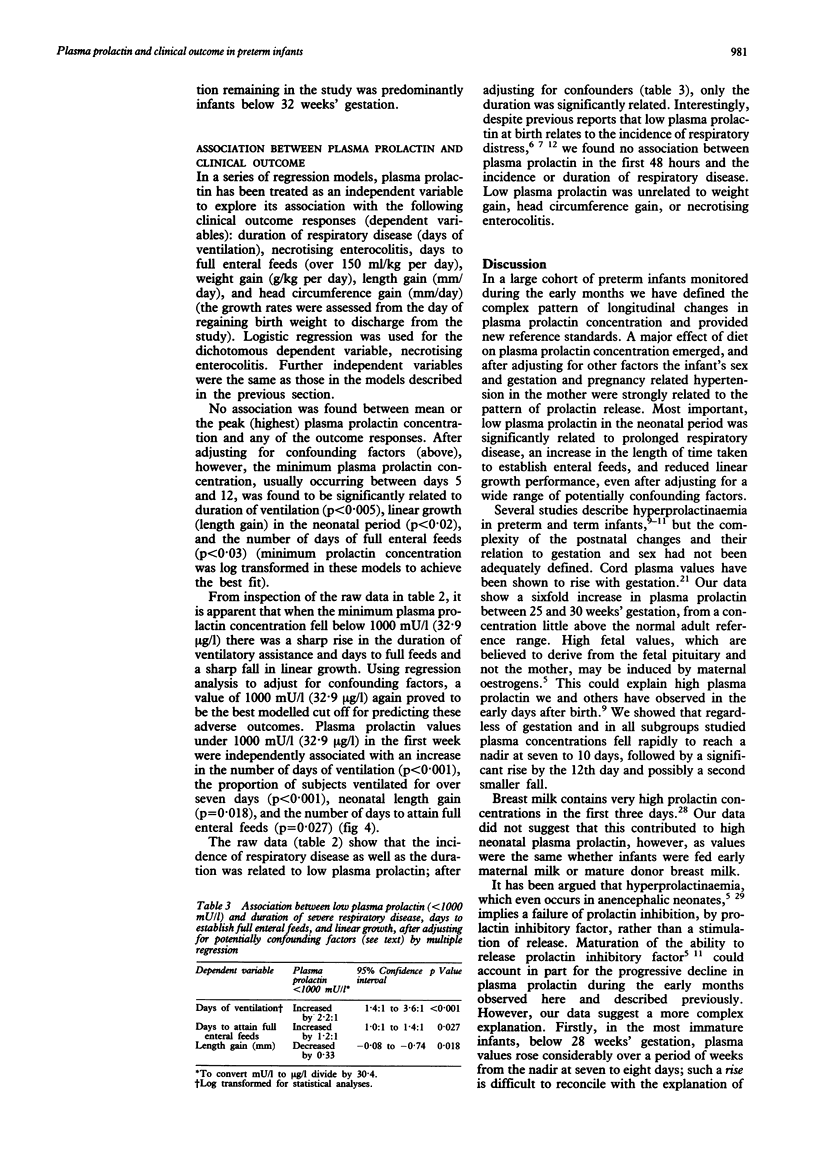
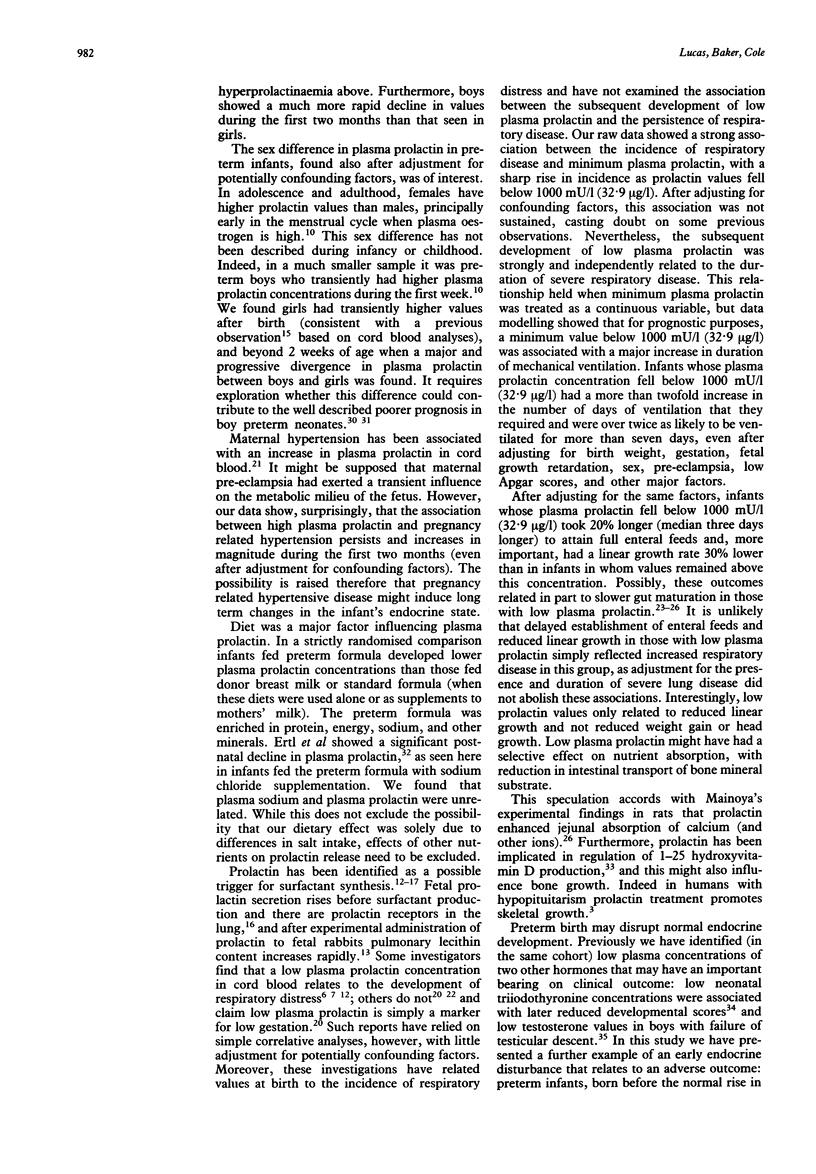
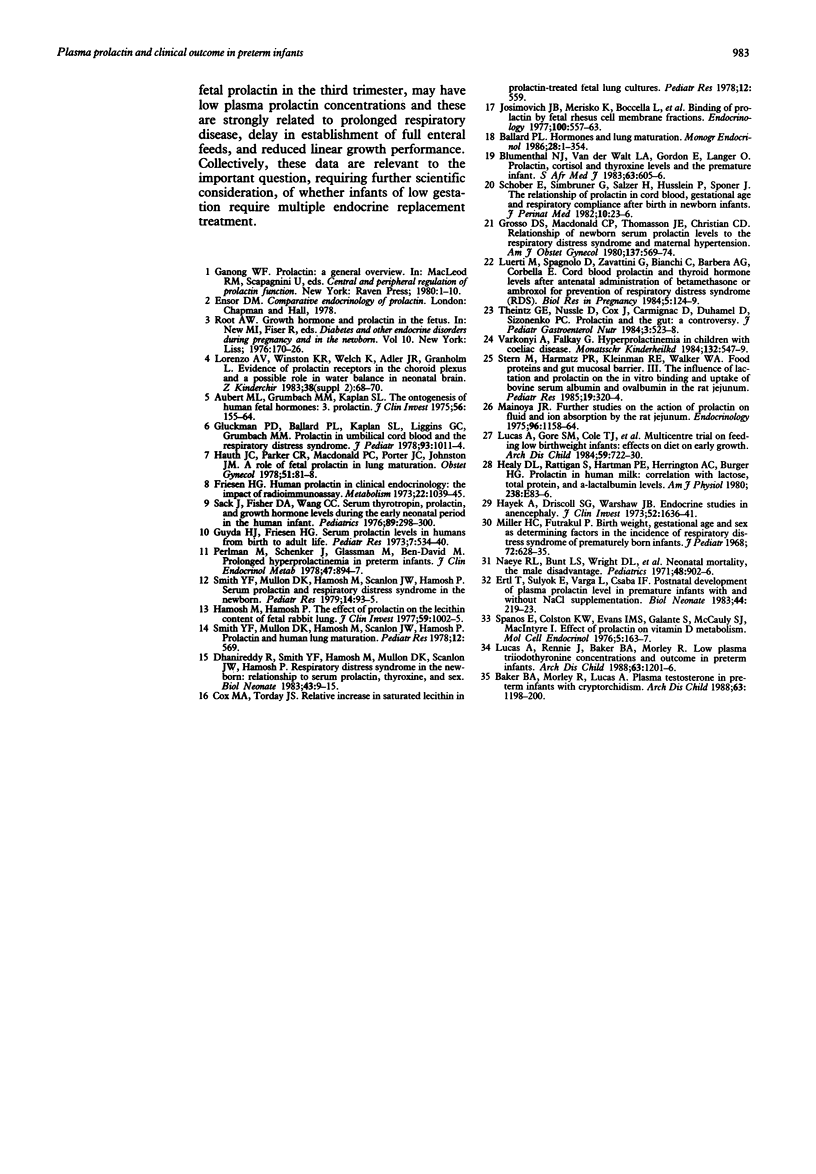
Selected References
These references are in PubMed. This may not be the complete list of references from this article.
- Aubert M. J., Grumbach M. M., Kaplan S. L. The ontogenesis of human fetal hormones. III. Prolactin. J Clin Invest. 1975 Jul;56(1):155–164. doi: 10.1172/JCI108064. [DOI] [PMC free article] [PubMed] [Google Scholar]
- Baker B. A., Morley R., Lucas A. Plasma testosterone in preterm infants with cryptorchidism. Arch Dis Child. 1988 Oct;63(10):1198–1200. doi: 10.1136/adc.63.10.1198. [DOI] [PMC free article] [PubMed] [Google Scholar]
- Ballard P. L. Hormones and lung maturation. Monogr Endocrinol. 1986;28:1–354. [PubMed] [Google Scholar]
- Blumenthal N. J., van der Walt L. A., Gordon E., Langer O. Prolactin, cortisol and thyroxine levels and the premature infant. S Afr Med J. 1983 Apr 16;63(16):605–606. [PubMed] [Google Scholar]
- Dhanireddy R., Smith Y. F., Hamosh M., Mullon D. K., Scanlon J. W., Hamosh P. Respiratory distress syndrome in the newborn: relationship to serum prolactin, thyroxine, and sex. Biol Neonate. 1983;43(1-2):9–15. doi: 10.1159/000241631. [DOI] [PubMed] [Google Scholar]
- Ertl T., Sulyok E., Varga L., Csaba I. F. Postnatal development of plasma prolactin level in premature infants with and without NaCl supplementation. Biol Neonate. 1983;44(4):219–223. doi: 10.1159/000241718. [DOI] [PubMed] [Google Scholar]
- Friesen H. G. Human prolactin in clinical endocrinology: the impact of radioimmunoassays. Metabolism. 1973 Aug;22(8):1039–1045. doi: 10.1016/0026-0495(73)90223-0. [DOI] [PubMed] [Google Scholar]
- Gluckman P. D., Ballard P. L., Kaplan S. L., Liggins G. C., Grumbach M. M. Prolactin in umbilical cord blood and the respiratory distress syndrome. J Pediatr. 1978 Dec;93(6):1011–1014. doi: 10.1016/s0022-3476(78)81240-2. [DOI] [PubMed] [Google Scholar]
- Grosso D. S., MacDonald C. P., Thomasson J. E., Christian C. D. Relationship of newborn serum prolactin levels to the respiratory distress syndrome and maternal hypertension. Am J Obstet Gynecol. 1980 Jul 1;137(5):569–574. doi: 10.1016/0002-9378(80)90697-3. [DOI] [PubMed] [Google Scholar]
- Guyda H. J., Friesen H. G. Serum prolactin levels in humans from birth to adult life. Pediatr Res. 1973 May;7(5):534–540. doi: 10.1203/00006450-197305000-00007. [DOI] [PubMed] [Google Scholar]
- Hamosh M., Hamosh P. The effect of prolactin on the lecithin content of fetal rabbit lung. J Clin Invest. 1977 May;59(5):1002–1005. doi: 10.1172/JCI108693. [DOI] [PMC free article] [PubMed] [Google Scholar]
- Hauth J. C., Parker C. R., Jr, MacDonald P. C., Porter J. C., Johnston J. M. A role of fetal prolactin in lung maturation. Obstet Gynecol. 1978 Jan;51(1):81–88. [PubMed] [Google Scholar]
- Hayek A., Driscoll S. G., Warshaw J. B. Endocrine studies in anencephaly. J Clin Invest. 1973 Jul;52(7):1636–1641. doi: 10.1172/JCI107343. [DOI] [PMC free article] [PubMed] [Google Scholar]
- Healy D. L., Rattigan S., Hartmann P. E., Herington A. C., Burger H. G. Prolactin in human milk: correlation with lactose, total protein, and alpha-lactalbumin levels. Am J Physiol. 1980 Jan;238(1):E83–E86. doi: 10.1152/ajpendo.1980.238.1.E83. [DOI] [PubMed] [Google Scholar]
- Josimovich J. B., Merisko K., Boccella L., Tobon H. Binding of prolactin by fetal rhesus cell membrane fractions. Endocrinology. 1977 Feb;100(2):557–563. doi: 10.1210/endo-100-2-557. [DOI] [PubMed] [Google Scholar]
- Lorenzo A. V., Winston K. R., Welch K., Adler J. R., Granholm L. Evidence of prolactin receptors in the choroid plexus and a possible role in water balance in neonatal brain. Z Kinderchir. 1983 Dec;38 (Suppl 2):68–70. doi: 10.1055/s-2008-1063079. [DOI] [PubMed] [Google Scholar]
- Lucas A., Gore S. M., Cole T. J., Bamford M. F., Dossetor J. F., Barr I., Dicarlo L., Cork S., Lucas P. J. Multicentre trial on feeding low birthweight infants: effects of diet on early growth. Arch Dis Child. 1984 Aug;59(8):722–730. doi: 10.1136/adc.59.8.722. [DOI] [PMC free article] [PubMed] [Google Scholar]
- Lucas A., Rennie J., Baker B. A., Morley R. Low plasma triiodothyronine concentrations and outcome in preterm infants. Arch Dis Child. 1988 Oct;63(10):1201–1206. doi: 10.1136/adc.63.10.1201. [DOI] [PMC free article] [PubMed] [Google Scholar]
- Luerti M., Spagnolo D., Zavattini G., Bianchi C., Barbera A. G., Corbella E. Cord blood prolactin and thyroid hormone levels after antenatal administration of betamethasone or ambroxol for prevention of respiratory distress syndrome (RDS). Biol Res Pregnancy Perinatol. 1984;5(3):124–129. [PubMed] [Google Scholar]
- Miller H. C., Futrakul P. Birth weight, gestational age, and sex as determining factors in the incidence of respiratory distress syndrome of prematurely born infants. J Pediatr. 1968 May;72(5):628–635. doi: 10.1016/s0022-3476(68)80005-8. [DOI] [PubMed] [Google Scholar]
- Naess O., Attramadal A., Aakvaag A. Androgen binding proteins in the anterior pituitary, hypothalamus, preoptic area and brain cortex of the rat. Endocrinology. 1975 Jan;96(1):1–9. doi: 10.1210/endo-96-1-1. [DOI] [PubMed] [Google Scholar]
- Naeye R. L., Burt L. S., Wright D. L., Blanc W. A., Tatter D. Neonatal mortality, the male disadvantage. Pediatrics. 1971 Dec;48(6):902–906. [PubMed] [Google Scholar]
- Perlman M., Schenker J., Glassman M., Ben-david M. Prolonged hyperprolactinemia in preterm infants. J Clin Endocrinol Metab. 1978 Oct;47(4):894–897. doi: 10.1210/jcem-47-4-894. [DOI] [PubMed] [Google Scholar]
- Sack J., Fisher D. A., Wang C. C. Serum thyrotropin, prolactin, and growth hormone levels during the early neonatal period in the human infant. J Pediatr. 1976 Aug;89(2):298–300. doi: 10.1016/s0022-3476(76)80472-6. [DOI] [PubMed] [Google Scholar]
- Schober E., Simbruner G., Salzer H., Husslein P., Spona J. The relationship of prolactin in cord blood, gestational age and respiratory compliance after birth in newborn infants. J Perinat Med. 1982;10(1):23–26. doi: 10.1515/jpme.1982.10.1.23. [DOI] [PubMed] [Google Scholar]
- Smith Y. F., Mullon D. K., Hamosh M., Scanlon J. W., Hamosh P. Serum prolactin and respiratory distress syndrome in the newborn. Pediatr Res. 1980 Feb;14(2):93–95. doi: 10.1203/00006450-198002000-00004. [DOI] [PubMed] [Google Scholar]
- Spanos E., Colston K. W., Evans I. M., Galante L. S., Macauley S. J., Macintyre I. Effect of prolactin on vitamin D metabolism. Mol Cell Endocrinol. 1976 Aug-Sep;5(3-4):163–167. doi: 10.1016/0303-7207(76)90080-0. [DOI] [PubMed] [Google Scholar]
- Stern M., Harmatz P. R., Kleinman R. E., Walker W. A. Food proteins and gut mucosal barrier. III. The influence of lactation and prolactin on the in vitro binding and uptake of bovine serum albumin and ovalbumin in the rat jejunum. Pediatr Res. 1985 Mar;19(3):320–324. doi: 10.1203/00006450-198503000-00014. [DOI] [PubMed] [Google Scholar]
- Theintz G. E., Nusslé D., Cox J., Carmignac D., Duhamel D., Sizonenko P. C. Prolactin and the gut: a controversy. J Pediatr Gastroenterol Nutr. 1984 Sep;3(4):523–528. doi: 10.1097/00005176-198409000-00008. [DOI] [PubMed] [Google Scholar]
- Várkonyi A., Falkay G. Hyperprolaktinämie bei Kindern mit Zöliakie. Monatsschr Kinderheilkd. 1984 Jul;132(7):547–549. [PubMed] [Google Scholar]


